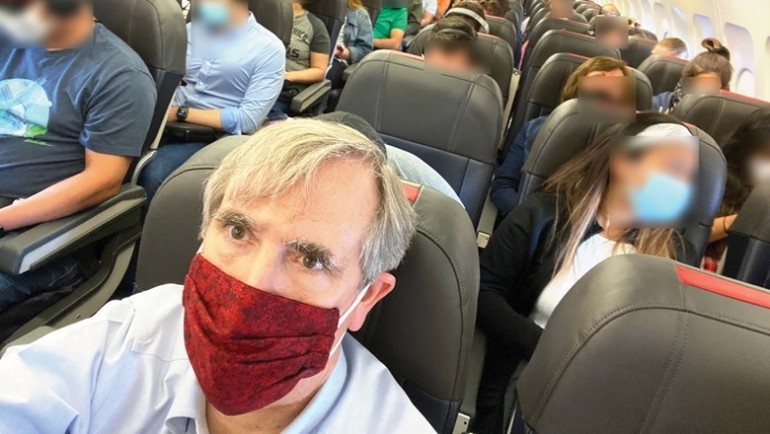Sponsored Listings:
In recent weeks, U.S. airlines have largely aligned their health measures as they seek to assure the public that it’s safe to fly.
On mandatory masks, health declarations at check-in and advocacy for the TSA to begin temperature screenings, the large U.S. carriers are now speaking with one voice.
But there’s a notable exception to this widespread agreement: seat blocking.
With the number of new reported Covid-19 cases in the U.S. trending at its highest levels yet, Delta, Southwest, JetBlue, Alaska and Hawaiian are all capping passenger loads at 70% or less. Frontier is taking a middle ground, blocking 20 middle seats per flight. American, United, Spirit and Allegiant are selling their usual seat inventory on each flight.
Carriers also sharply diverge in their rhetoric on the subject.
For example, in a June 26 press release, Delta chief customer experience officer Bill Lentsch said that “reducing the overall number of customers on every aircraft across the fleet is one of the most important steps we can take to ensure a safe experience for our customers and people.”
The carrier has committed to blocking 40% of economy seats and 50% of domestic first-class seats through Sept. 30.
Conversely, on July 1 United chief communications officer Josh Earnest dismissed seat blocking as a gimmick and noted that leaving middle seats open doesn’t come close to providing passengers with 6 feet of distancing.
“When it comes to blocking middle seats, that’s a PR strategy, not a safety strategy,” Earnest said.
But while airlines differ on the efficacy of seat blocking, medical experts largely agree that blocking middle seats, though less important than requiring masks, does have a meaningful impact on reducing the likelihood of in-flight Covid-19 transmission.
The question got a public airing on June 30, when Centers for Disease Control and Prevention (CDC) director Robert Redfield testified in a Senate committee hearing that American sent the wrong message when it announced that week that it would begin selling its full seat inventory for flights beginning July 1.
“Obviously, there was substantial disappointment,” Redfield said of the CDC’s reaction to the move.
In response, American asserted that it has “multiple layers of protection in place for those who fly with us, including required face coverings, enhanced cleaning procedures and a pre-flight Covid-19 symptom checklist.”
Other experts back Redfield’s view.
“Layering on spread-slowing measures such as mandating masks on flights and not filling the middle seat may be the interim remedy for spread that we need,” said Kagya Amoako, a biomedical engineering professor at the University of New Haven in Connecticut.
Wearing masks is the more important of those two measures, he added. But he said that separating passengers by even the approximately 18 inches of a middle seat can provide a meaningful reduction in Covid-19 transmission risk.
That’s especially the case since the typical up-to-down cabin airflow pattern on airliners could serve as a barrier to sneeze droplets traveling between passengers.
“Viral load amount that can be exchanged between passengers separated by an empty seat will, in theory, be smaller than that between elbow-rubbing passengers,” Amoako said.
Janet Jokela, an infectious disease specialist at the University of Illinois, concurred.
“Twelve feet is better than 9 feet, is better than 6 feet, is better than 1 foot,” she said.
Nevertheless, and not withstanding Redfield’s Senate testimony, the federal government has taken only a hesitant official position on seat blocking.
“Airlines should consider the feasibility of limiting seat availability to enable passengers to maintain social distance from each other during the flight,” reads a federal framework for mitigating risks in air travel, which was released July 1.
The document calls on airlines to alert customers ahead of flights on which the passenger load will make social distancing unachievable, a measure already being taken by United and American.
Business considerations, including resistance from the airline industry, might factor into the government’s middle-line stance. In May, IATA called on authorities around the world to steer clear of regulations that mandate seat blocking. The trade group said that if middle seats were blocked by government order, the break-even ticket price on North American flights would increase by $87 on average.
Industry analysts say U.S. airlines that are blocking middle seats are doing it as a business strategy, rather than for health safety. But they question whether the move will pay off, especially for Delta, which is blocking the most seats per flight and is also being conservative about its overall schedule buildup. In addition, only Delta and Southwest have promised seat blocking all the way through September.
“It seems like Delta is willing to take a hit to be promoted as the most health-safe airline,” said Brett Snyder, a travel advisor who pens the Cranky Flier blog. “They are making some bet that they think that it is going to help them in the long run.”
That bet could backfire, Snyder added, if Delta ultimately drops the policy before the pandemic has ended.
Judson Rollins, founder of the consultancy Propel Aviation Solutions, said he believes Delta is aggressively blocking seats to put itself in a more preferred position among high-end customers.
“I think Delta is thinking that it can make more money with higher yields and lower load factors,” he said.
But if the strategy is a marketing one, he too is wary.
“I don’t think it makes any sense to brand yourself as a supersafe carrier and then roll it back at the end of September, when the pandemic isn’t close to being over,” Rollins said.
Source: travelweekly.com










